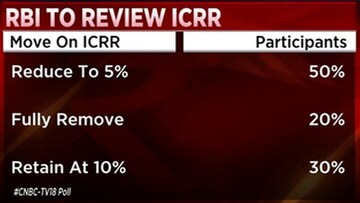Bond markets in India are on edge as they await the Reserve Bank of India's (RBI) much-anticipated decision on the incremental
cash reserve ratio (ICRR), set to be reviewed today (September 8). This newly introduced ratio has kept banks and bond markets in a state of suspended animation, as its removal could bring significant relief to financial institutions, but the actual outcome remains uncertain.
The
RBI introduced the ICRR of 10 percent on deposits collected by banks between May 19 and July 28. The primary rationale cited at the time was to control excess liquidity in the system due to the return of 2000 rupee notes. However, it is widely speculated that the RBI's true motivation was to counter rising inflation, which had been a growing concern.
As the RBI's decision day approaches, market sentiment is divided. A CNBC-TV18 poll revealed that 50 percent of respondents expect the ICRR to be reduced to around 5 percent. A minority, constituting 20 percent, hopes for a complete removal, while another 30 percent anticipate that it will be retained in full.
RBI's liquidity tightening measures have generated uncertainty in the financial landscape. The central bank initially drained approximately Rs 1.1 lakh crore from the system, resulting in a liquidity deficit. However, subsequent government spending has led to a surplus liquidity of about Rs 80,000 crore to Rs 1.5 lakh crore.
The looming challenge for
RBI is whether to continue with liquidity tightening. On September 15, advanced tax payments will naturally tighten liquidity. This has led to debates within the financial community about the necessity of additional tightening measures.
Watch: Samiran Chakraborty, Chief Economist-India at Citi and A Prasanna, Chief Economist at ICICI Securities-Primary Dealership in interaction with CNBC-TV18 on
ICRR & liquidity in banking system According to Latha Venkatesh of
CNBC-TV18, the RBI is inclined towards removing the ICRR. It was originally designed for temporary liquidity management and may no longer be suitable for the current economic conditions. Instead, the RBI might adopt a more flexible approach, employing a variable rate reverse repo (VRRR) during periods of excess liquidity and a variable rate repo during times of liquidity
deficits. Additionally, the RBI's sale of dollars to counter the weakening rupee could absorb excess liquidity.
For more details, watch the accompanying video
(Edited by : C H Unnikrishnan)
First Published: Sept 7, 2023 5:34 PM IST




